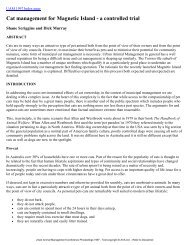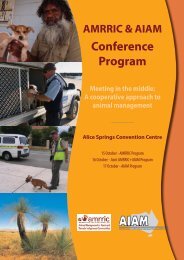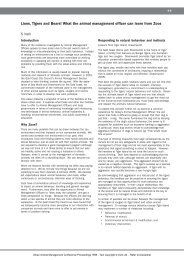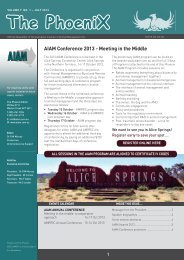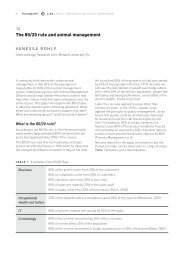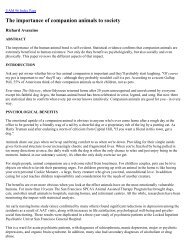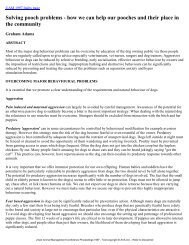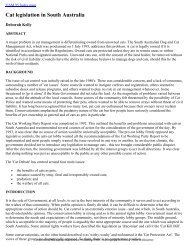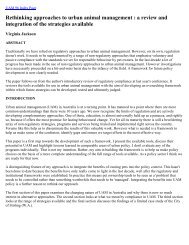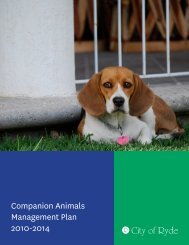Proceedings OF ThE - Australian Institute of Animal Management Inc
Proceedings OF ThE - Australian Institute of Animal Management Inc
Proceedings OF ThE - Australian Institute of Animal Management Inc
Create successful ePaper yourself
Turn your PDF publications into a flip-book with our unique Google optimized e-Paper software.
10 <strong>Proceedings</strong> 2012<br />
AIAM Annual Conference on <strong>Animal</strong> <strong>Management</strong><br />
the boundaries <strong>of</strong> all <strong>Australian</strong> municipalities, all<br />
the time. And if that all sounds perhaps a little more<br />
complicated than anyone thought in the beginning…<br />
well, that’s correct – because it certainly is!<br />
2. Why bother?<br />
To further understand the complete story <strong>of</strong> <strong>Animal</strong><br />
<strong>Management</strong>, we also need to appreciate the full<br />
picture <strong>of</strong> why we do it. There are in fact three levels<br />
<strong>of</strong> understanding in the question <strong>of</strong> “why” as follows.<br />
On the face <strong>of</strong> it, <strong>Animal</strong> <strong>Management</strong> is a Local<br />
Government community service intended to realise<br />
the following two goals:<br />
1. Reduce pet nuisance; and<br />
2. Promote responsible and community considerate<br />
pet animal ownership.<br />
Figure 1 shows the significance <strong>of</strong> animal related<br />
nuisance in terms <strong>of</strong> the weight <strong>of</strong> complaints on this<br />
subject to Townsville City Council. For Service Request,<br />
read complaint. This weight <strong>of</strong> complaint to councils<br />
about animal related problems is not unusual in a<br />
national context. Figure 1 supports the notion that<br />
pet animals can be a significant cause <strong>of</strong> public<br />
nuisance. So, the first layer <strong>of</strong> purpose for <strong>Animal</strong><br />
<strong>Management</strong>, is to reduce community nuisance by<br />
promoting competency <strong>of</strong> animal ownership.<br />
Figure 1<br />
Behind this understanding, lies a second layer <strong>of</strong><br />
purpose that relates to essential underpinning<br />
governance and “policy” matters for Local<br />
Government.<br />
These governance and policy matters include<br />
aspects pertaining to public health, public safety<br />
and community amenity as illustrated for example<br />
by Figure 2. regarding dog attacks recorded by<br />
Townsville City Council in 2010/11.<br />
Figure 2<br />
On careful examination, it can be seen that <strong>Animal</strong><br />
<strong>Management</strong> is a municipal service that dovetails<br />
with Government’s quadruple bottom line <strong>of</strong><br />
obligation as follows:<br />
1. Community (public health, welfare and amenity),<br />
2. Economy (commercial activity and employment),<br />
3. Environment (wildlife and habitat protection), and<br />
4. Governance (transparency and integrity <strong>of</strong><br />
community service delivery).<br />
It can be seen from this,<br />
that Councils provide<br />
animal management<br />
service because it is<br />
comprehensively in<br />
the best interests <strong>of</strong><br />
the communities they<br />
should do so.<br />
Then there is a third<br />
layer <strong>of</strong> <strong>Animal</strong><br />
<strong>Management</strong> purpose<br />
that relates to why it<br />
is that so many people<br />
want to (and do) keep<br />
on keeping companion<br />
animals in our<br />
society. Without this<br />
understanding there<br />
is no fundamental<br />
baseline that truly justifies this whole <strong>Animal</strong><br />
<strong>Management</strong> business. A summary <strong>of</strong> this third layer<br />
<strong>of</strong> understanding <strong>of</strong> why we do <strong>Animal</strong> <strong>Management</strong><br />
is provided both succinctly and completely by Tamara<br />
Shardlow 2 as follows:<br />
“Simply put, pets are an <strong>Australian</strong> way <strong>of</strong> life and<br />
clearly, one that we very much enjoy. Research shows<br />
that eight in ten <strong>Australian</strong>’s have at some stage owned<br />
a pet, while every second home now plays home to a<br />
pet dog or cat. But if we peel back the generally agreed<br />
upon notion that a well behaved pet is rather nice to be<br />
around, we’ll find a bank <strong>of</strong> research documenting why.<br />
Across the past 30 years, the sheer weight <strong>of</strong><br />
international and national studies that examine the<br />
relationship between companion animals and range<br />
<strong>of</strong> correlating human health benefits is staggering.<br />
Not only are pet owners psychologically 3,4,5 ,<br />
2 Pers Comm Tamara Shardlow, PIAS. April 2012.<br />
3 McConnell, AR, Brown, CM, Shoda, TM, Stayton, LE, Martin, CE, 2011, ‘Friends with benefits: on the positive consequences <strong>of</strong> pet ownership’, Journal<br />
<strong>of</strong> Personality & Social Psychology, vol.101, no.6, pp.1239-1252<br />
4 Straede, CM, & Gates, GR, 1993, ‘Psychological Health in a Population <strong>of</strong> <strong>Australian</strong> Cat Owners’, Anthrozoos, vol. VI, no. 1, pp. 30-42.<br />
5 Garrity, TF, Stallones, L, Marx, MB, & Johnson, TP, 1989, ‘Pet ownership and attachment as supportive factors in the health <strong>of</strong> the elderly’, Anthrozoos,<br />
vol. 3, pp. 35-44.



